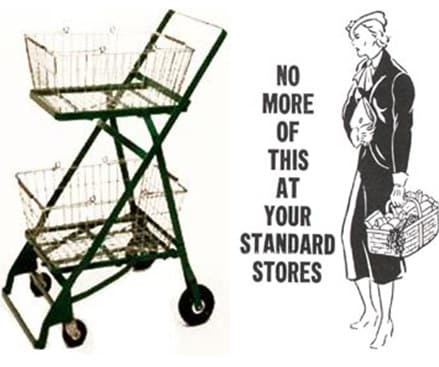Forget Steve Jobs. The entrepreneur that most changed consumer behaviour is a relative unknown – even though you use his invention daily.
Shopping is my least favourite contact sport. I always manage to get the shopping trolley with the wonky wheels, and have a knack of picking the time of day when hordes of kids descend on the store and use the aisles as a roller derby.
The trouble is that the humble trolley and the inventor is one of my all-time favourite entrepreneurial stories.
It has everything in it: Innovation; bouncing back from failures; creativity; psychology; marketing skills and a huge dose of cheekiness.
Forget Steve Jobs. Sylvan Goldman: Shopping Trolley inventor made the most difference to consumers.
The Aha Moment
Sylvan Goldman owned the Humpty Dumpty chain of five supermarkets in Oklahoma City in the 1930’s. Concerned with dwindling sales, he spent a lot of time watching the customers in his store, trying to work out how to get them to buy more.
At the time, the only option when people shopped was to carry a cane basket for their groceries. When the baskets became full, they also became heavy, which meant people headed for the checkout. The amount people spent was limited by how much they could carry.
He tried hiring employees to collect full baskets from people and take them to the register, handing the customer an empty one to continue shopping. This quickly turned into a logistical nightmare, and he soon abandoned the idea.
Late one night in his office, Goldman was sitting staring idly at some folding chairs against the wall.
He then had a brainwave. What if he put a basket on the seat and wheels on the legs?
He called in one of his employees, Fred Young, who also worked as a local handyman.
Using the folding chair design, they created the first shopping trolley prototype. It had a metal frame and two wire baskets – one on top of the other.
The baskets could then be removed and the trolleys folded flat to take up less space once they were finished being used by customers.
Goldman took the concept to another handyman to work out how to mass-produce the new invention.
The First Attempt
He launched his new invention with great fanfare and hope.
His first ad ran with the tagline “It’s new. It’s sensational. No more baskets to carry,” next to a photo of a woman struggling with a full basket.
And people ignored it in droves.

Men were worried it made them look less of a man – and felt it suggested they were not strong enough to carry a basket.
Women thought it looked too much like a baby carriage (and they were over pushing babies around).
Elderly people were torn. Some worried that it made them look feeble, while others embraced the idea with joy.
The Second Failure
Goldman also tried selling the concept to other retailers, who were worried that feral children would grab them and then knock into people and displays, knocking them flying. (Give those retailers a gold star: Those fears came to pass).
Going back to the drawing board Goldman thought for many a long night on how to get people to use the trolleys.
Tapping Into People’s Brains
He was a bit of an amateur psychologist, so his solutions tapped into and addressed the common fears that stopped people from using his trolleys.
His creative solutions included:
- Hiring pretty girls to hand people a trolley the moment they entered the store instead of the older style shopping baskets. If people said they didn’t want one, the girl would say while looking into the store “But everyone else is using one.”
- He hired manly looking men and good-looking women to wander his stores pushing fully laden trolleys through the shops and carparks.
- He had employees who had children pretend to be customers, and filmed them and their amazingly well behaved children with the trolleys. He then showed this film to other retailers to convince them their fears were unfounded.
- He advertised the new invention widely in the papers so the early adopters would know about it, and he also used local celebrities to endorse the idea.
Success!
This time it worked. It didn’t just work, it was a barnstorming success.
It was patented on April 9, 1940 as a “Folding basket carriage for self-service stores.”
Soon the folding basket carriers were so popular there was a seven-year wait for manufacture. The royalties from the patent made Mr Goldman a multi-millionaire.
Disruptive Technology (That is Battery Free)
One of the unforeseen changes was that the new-fangled shopping trolleys disrupted the design of stores, with new stores needing to be built with wider aisles and longer checkouts to process all the extra groceries going through.
The trolley revolutionised retail and transformed how people live and shop.
Over the years, the shopping trolley baskets got bigger. A new invention created fixed baskets that telescoped into each other. This became the subject of substantial patent and licensing wars between Goldman and Orla E. Watson (the inventor).
Later years saw the addition of child seats, branded cart handles and magnetic wheel locks to stop people taking the trolleys out of the carpark.
Everything Old Is New Again
In recent times, we have seen modern day supermarkets going back to the basics.
While massive trolleys are great for large shopping trips, until recently people only had the choice of the behemoth trolleys or a small plastic basket. Supermarkets have now introduced a range of smaller trolleys and baskets on wheels that bridge the gap, and once again people have taken to them in droves and the average basket sale has increased as a result.

Now Iconic
Ten years after his death, the shopping trolley was turned into an icon and the image is now used across every digital website selling products on the net.
“A great idea by itself won’t make you money. People must want and use your idea.”
What Can You Learn From The Humble Shopping Trolley?
- A great idea by itself won’t make you money. People must want and use your idea.
- Ads by themselves are not enough. You need an online and an offline marketing strategy for your products.
- Don’t underestimate peer pressure. If they see other people enjoying your product, or saying how great your product is, it makes them more willing to try it.
- Video marketing worked in the 1940s and still works.
- Sometimes you need to persevere with an idea that you truly believe in.
- One idea can change the world.
Further Reading
http://www.todayifoundout.com/index.php/2015/12/invention-shopping-cart/
http://mentalfloss.com/article/26470/brief-history%E2%80%94and-future%E2%80%94-shopping-cart
http://priceonomics.com/how-a-basket-on-wheels-revolutionized-grocery/
https://thesocietypages.org/socimages/2015/04/10/the-story-of-the-shopping-cart/



